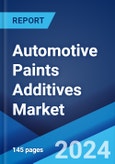Automotive paint additives refer to formulations that improve the quality, functionality, and characteristics of paints and coatings. It includes wetting and dispersing agents, emulsifiers, defoamers, catalysts, rheology modifiers, driers, anti-setting agents, and effluent treatment additives. Automotive paint additives are widely used in interior and exterior vehicle paints to improve their durability, prevent chipping and fading, and protect vehicles from rust, ultraviolet (UV) radiation, and corrosion. They are odorless products that exhibit chemical inertness, temperature resistance, and antifungal and antibacterial properties. Automotive paint additives increase the viscosity of the paint, enhance fluidity, reduce sedimentation, and prevent bubble formation. They help to increase paint hardness, accelerate drying time, improve brush ability, and enhance performance. As a result, automotive paint additives find extensive applications in passenger, commercial, and military vehicles.
Automotive Paints Additives Market Trends:
The significant growth in the automotive industry is one of the primary factors driving the market growth. Automotive paint additives are widely used to enhance the aesthetic appeal of vehicles, provide a smooth surface finish, reduce the fisheye distortion in the painted surface, and prevent corrosion and deterioration of various metal, vinyl, leather, and plastic body parts, such as windows, doors, trims, seats, chassis, engine, transmission, dashboard, convertible tops, tanks, and underbody. In addition to this, the widespread product utilization to develop lightweight paints for electric and hybrid vehicles, which improves battery capacity and provides longer traveling distances between charges is acting as another growth-inducing factor. Furthermore, the widespread product utilization to enhance the visual effects of the decoration, provide high color saturation, and boost the reflectivity of metallic finish while maintaining a smooth and non-sparkling appearance is facilitating the market growth. Additionally, the introduction of eco-friendly products that are water-based that do not contain harmful volatile organic compounds (VOCs) and improve the paint's durability is positively influencing the market growth. Along with this, the implementation of stringent regulations by several governments across the globe to promote the adoption of eco-friendly paints that minimizes adverse impact on human health and the environment is propelling the market growth. Moreover, the recent development of advanced products that are lightweight, safe, stable, and easy to use and provide improved dispersion and excellent flow behavior is favoring the market growth. Other factors, including rising demand for anti-fouling and anti-graffiti paints for automotive, increasing expenditure capacities of consumers, and easy product availability across e-commerce platforms, are anticipated to drive the market growth.Key Market Segmentation:
This report provides an analysis of the key trends in each segment of the global automotive paints additives market, along with forecasts at the global, regional, and country levels from 2025-2033. The report has categorized the market based on type, vehicle type, and application.Type Insights:
- Fisheye Eliminator
- Blending Solvents
- Flow Enhancers
- Others
Vehicle Type Insights:
- Passenger Cars
- Commercial Vehicles
Application Insights:
- Automotive Decorative Paint
- Automotive Antirust Paint
- Automotive Fire-retardant Paint
- Others
Regional Insights:
- North America
- United States
- Canada
- Europe
- Germany
- France
- United Kingdom
- Italy
- Spain
- Others
- Asia Pacific
- China
- Japan
- India
- South Korea
- Australia
- Indonesia
- Others
- Latin America
- Brazil
- Mexico
- Others
- Middle East and Africa
Competitive Landscape:
The report has also provided a comprehensive analysis of the competitive landscape in the global automotive paints additives market. Competitive analysis such as market structure, market share by key players, player positioning, top winning strategies, competitive dashboard, and company evaluation quadrant has been covered in the report. Also, detailed profiles of all major companies have been provided. Some of the companies covered include BASF SE, Clariant AG, Dupont De Nemours Inc., Eastman Chemical Company, PPG Industries Inc., Sherwin-Williams Company, Solvay S.A, etc.Key Questions Answered in This Report:
- How has the global automotive paints additives market performed so far, and how will it perform in the coming years?
- What are the drivers, restraints, and opportunities in the global automotive paints additives market?
- What is the impact of each driver, restraint, and opportunity on the global automotive paints additives market?
- What are the key regional markets?
- Which countries represent the most attractive automotive paints additives market?
- What is the breakup of the market based on the type?
- Which is the most attractive type in the automotive paints additives market?
- What is the breakup of the market based on the vehicle type?
- Which is the most attractive vehicle type in the automotive paints additives market?
- What is the breakup of the market based on application?
- Which is the most attractive application in the automotive paints additives market?
- What is the competitive structure of the global automotive paints additives market?
- Who are the key players/companies in the global automotive paints additives market?
Table of Contents
Companies Mentioned
- BASF SE
- Clariant AG
- Dupont De Nemours Inc.
- Eastman Chemical Company
- PPG Industries Inc.
- Sherwin-Williams Company
- Solvay S.A








